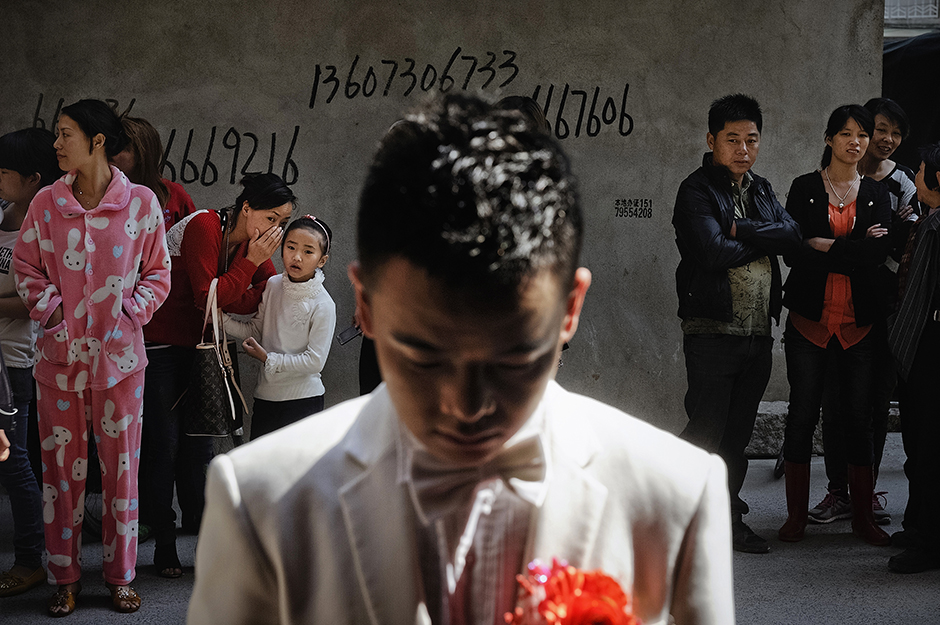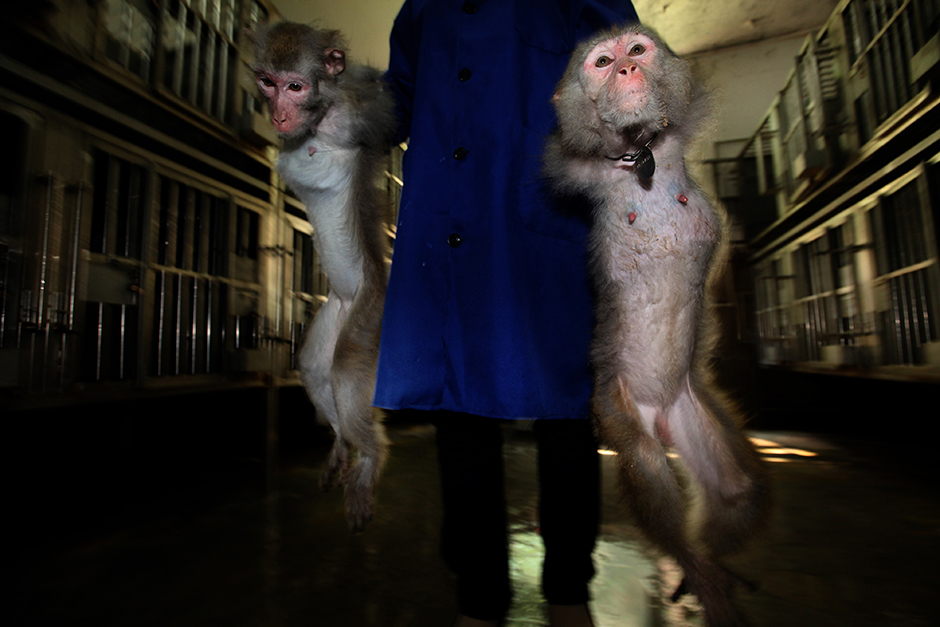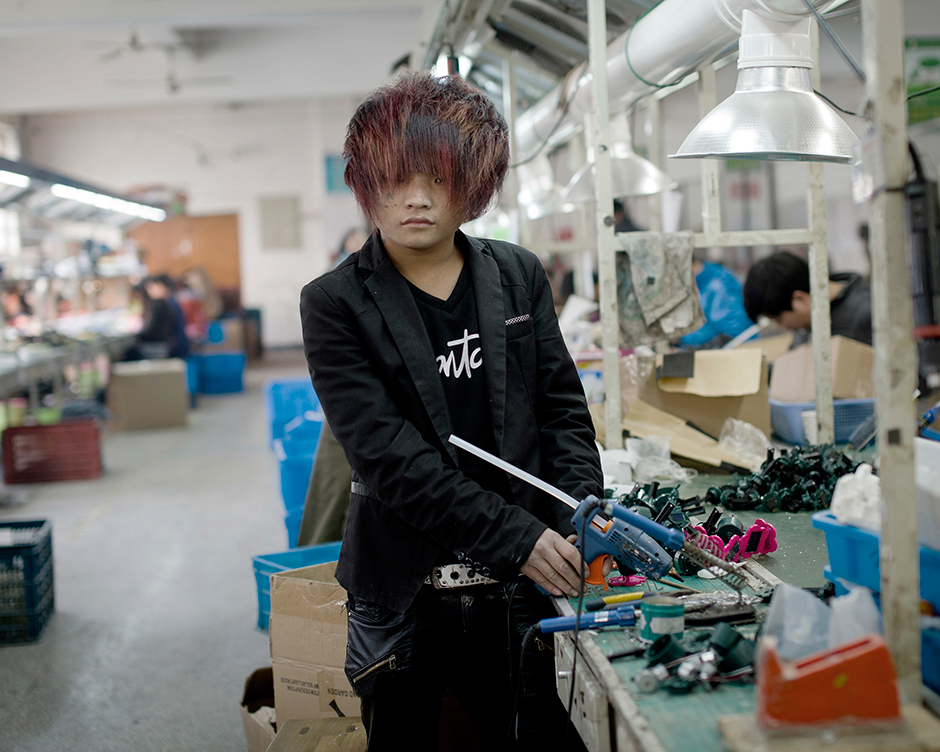Photographers document China’s breakneck development in fractions of a second every single day. Yet the work of Chinese photojournalists remains largely unseen outside their homeland. Of the thousands of images of the country illustrating the pages of international websites, newspapers, and magazines, most are made by photographers who come from someplace else.
A few Chinese photographers—shooters such as Lu Guang, who is best-known for documenting China’s environmental degradation and the HIV epidemic in the central province of Henan—do get their work out to an international audience. With two World Press Photo awards to his name and a grant from the prestigious W. Eugene Smith Memorial Fund. Lu’s exposure is one of the few exceptions that proves the rule. The work of Du Bin is another.
Most Chinese photojournalists toil in relative anonymity even within China, since there are few quality Chinese outlets for their photography. For the first three decades of Communist Party rule—from 1949 through the end of the Cultural Revolution—photojournalism was corralled into carrying tightly-controlled state-approved messages in pictures. Impartial news coverage wasn’t possible.
“In the broad context, photography was seen as a tool to document China—be it the building of the army, social construction, or rural agricultural life and so on. It was a doctrine,” says Heung-Shing “H.S.” Liu, a Pulitzer Prize-winning American photographer who began covering China for TIME in 1976, the year Mao died, then for the Associated Press, and who still lives and works in Beijing.
Although China’s official policy of opening up began in 1978, Liu says it wasn’t until the late 1990’s that photography moved away from propaganda toward a more unencumbered depiction of news and daily life. The arrival of the Internet in China in 1994, and the spread, in the late 1990s, of affordable digital cameras, gave more ordinary Chinese the tools to produce and publish their own images.
But Liu says a “conspicuous lack of training for photo editors,” means the best pictures are often overlooked or used improperly.
Until the 1990s, recruitment of editors and photographers was tightly controlled. “People didn’t go to journalism school or university,” Liu says. “Photographers were literally plucked out of the ranks of demobilized army and society … [and had to] fulfill a checklist of qualifications. China was still embedded in the idea of the proletariat.”
“The national papers in China by default have forfeited the platform because they use photography so poorly—they have a platform in their hand but are not using it,” he says. “The question is not whether Chinese photographers’ works are seen by the outside. It would be great if the great Chinese photographers would be seen by Chinese, period.”
To begin to remedy this problem, the China Photojournalists Society, a part of China’s official news agency, Xinhua, established the first China International Press Photo contest (CHIPP) in 2005. In the spring of 2013, after working on and off as a photographer in China for five years and being published in Newsweek and National Geographic books, I was invited to be a CHIPP judge. I discovered first hand just how far Chinese photojournalists have come in a relatively short period and how they now cover a breadth of stories with access, nuance, and insight difficult for visiting photographers like me to achieve. The CHIPP contest struck me as surprisingly uncensored.
While international photographers scooped up many of the major CHIPP prizes last year, Chinese photographers won awards for their work on internal migration, food safety scandals, and survivors of China’s 1942 famine. Entries that didn’t make it to the finals, shot in China’s far-flung regions and in the hidden corners of its best known cities, showed everything from disappearing ethnic minorities to a Weegee-eqsue series on undercover police arrests in the Southern China province of Guangdong.
* * *
“Gay Marriage,” by Zhou Pinglang, won the CHIPP silver medal for a single photograph in the Daily Life category. At first, Zhou’s image of a gay wedding in China was censored by editors at the Guangdong-based Information Times. Discussion of homosexuality is still largely taboo in China and the editors considered the image overly risky. But CHIPP’s recognition of the photograph paved the way for its eventual publication in the very newspaper that initially had suppressed it.
The Chinese media seldom portrays gays. Homosexuals don’t face discrimination on religious grounds. “Chinese people have few religious beliefs,” Zhou says. Instead, debate about homosexuality simply is hidden. “Politicians avoid it just to be discreet and safe.”
“Most people think, ‘So long as it’s not my kid, then it’s okay’,” Zhou explains. Yet it wasn’t until 2001 that Beijing removed homosexuality from China’s official list of mental illnesses. Families that adhere to traditional values exert pressure on homosexual men to marry women.
“Homosexuals can live a good life if they live a low key life,” says Zhou, observing the way things are, not the way he thinks they should be.
Zhou’s winning picture brings to light a dark and intimate moment. One of the betrothed men lowers his head in the foreground while the background is filled with whispered gossip, hostile body language, and expressions of disdain.
The wedding was not legally binding, but the ceremony publicly celebrated the union between twenty-four-year-old Lu Zhong and twenty-year-old Liu Wangqiang in the couple’s hometown in Fujian. They saw a good turnout of friends, but the couples’ parents did not accept their invitations. The lone family member to attend was a sister.
When gay issues are covered in China, it tends to be voyeuristic, Zhou says, warning that readers are “aroused and entertained,” but nothing more.
“I want to strengthen social consideration of these issues,” he says. “The pictures contain public attitudes and I want to ask questions about impacts that public opinion has.”
Zhou’s approach to photography was shaped by his study of philosophy in Shanghai at Fudan University, one of China’s top schools. Now twenty-five, Zhou fell into photography soon after he graduated.
“After only two years, I’ve come to realize that the relationship between subject and photographer is based on mutual benefit. It’s a double win—you get your report and the other side gets their issue raised. It feels miserable and pathetic at times,” Zhou says.
“You need to understand society, to observe and reflect. Your reportage must have purpose,” he says. “There’s a lot of good work coming out of China, because China itself is interesting. There have been so many changes.”
* * *
“Chinese Breeding of Monkeys for Experiment,” by Li Feng, won the CHIPP silver medal for a photography story in the Economy, Science and Technology News category. The photo series adds depth to the fraught discussion of China’s treatment of animals.
Li’s pictures show laboratory monkeys bred in China. What’s not immediately clear, Li explains, is that they are exported primarily to America and Europe. Multinational pharmaceutical companies favor Asian monkeys because they are comparatively cheap, he says. Like so many China stories, this one directly touches lives worlds away.
“I want to tell everyone that testing on animals doesn’t only involve China or one people or group but extends to all human beings,” says Li, forty-four. Despite attempts to find alternatives, the number of animals used in laboratory research to develop pharmaceuticals and improve defense science and technology is on the rise.
Li hails from Yichang, a city on the Yangtze River close to the famous Three Gorges. He’s a self-professed animal lover and centers his work on humans’ relationship with the environment. The lab monkeys series departs from his typical work, which has tended to capture wildlife in nature. In the lab series, we see the monkeys close up, adapting to captivity. One picture shows both monkey and scientist watching to see how much fluid is left in an intravenous injection in the monkey’s arm. The close-up focuses on the monkey’s eyes, so the viewer shares the tiny Macaque’s anticipation, anxiety, and vulnerability.
Li has worked for several years capturing images of monkeys. In 2005, he stumbled on a breeding center while working on a project for the State Forestry Administration.
A couple of years later, Li won a National Geographic award. The recognition prompted him to explore the story of the monkeys at greater depth.
“I realized that first picture was just the tip of the iceberg,” Li says. “It took me a few months to photograph, but two years to gain access.”
At first, administrators afraid of negative press would not allow Li anywhere near the facilities, which are typically hidden in remote locations.
“They didn’t want to expose themselves,” he recalls. “They sympathize with the monkeys; they think it’s inhumane and were afraid the opposition would be too loud.”
Finally, after two years, Li got a break through a friend of a friend. He makes it clear he never was campaigning against animal testing, but trying to explore the issue and bring it to public debate.
“After I finally got in, I realized that many of the facilities were better than most zoos,” he says.
One attribute Chinese photojournalists need in surplus is tenacity. After all the trouble he had gaining access to the facility, Li’s pictures were nearly censored.
“The media didn’t dare publish the work,” he says, adding that in the end he managed to convince editors it was important to show the real situation. “The environment for photographers is tough, so we have to be tough to survive.”
Last March, state-run China Central Television news posted Li’s pictures on its official weibo microblog account under the heading, “The Downside of Experimenting on Monkeys to Improve Modern Medical Science is Their Blood and Death.” The pictures drew 1,544 comments and were reposted or shared by 3,365 weibo users.
* * *
“Young Workers from Rural Areas,” a series of portraits by photographer Li Zhenyu, won the 2013 CHIPP gold medal for a story in the Portraits & People in the News category.
Li Zhenyu’s subjects appear in construction sites and factories—settings that fit the migrant worker narrative—yet his pictures shatter old stereotypes.
They bring us face-to-face with the gaudy fashion and big blow-dried hair of rural migrants born after 1990, whose often conspicuous style sometimes includes a mélange of shiny nylon and lace, worn on the factory floor without irony. Many of these post-1990 migrants started working in the cities in their mid-to-late teens. Most can’t farm and have no intention of returning to the countryside. Their level of education and earning power are low, and policies restrict their access to social services, making them second class citizens in the cities they are helping to build.
“They are from backward villages and unable to fully integrate into city life,” explains thirty-five-year-old Li, a native of Jiangsu province on China’s east coast. “In the eyes of city people, their hairstyle and dress is totally out of fashion. They try to join urban society but they can’t, and their attempts to do so are kind of awkward and embarrassing.”
Moreover, Li says, “Unlike their parents, who don’t question the current state of affairs, the younger generation is rebellious.”
Perhaps they recognize they may never achieve the acceptance and security they crave. The first generation of migrants to China’s cities worked in the very same jobs in order to give their kids an education and better opportunities. There was sacrifice, but there was an aim. For the new generation, factory work is tough cycle to break.
“Due to the limitations of income, education, and culture, the new generation of rural workers haven’t really improved compared to their parents,” Li says.






